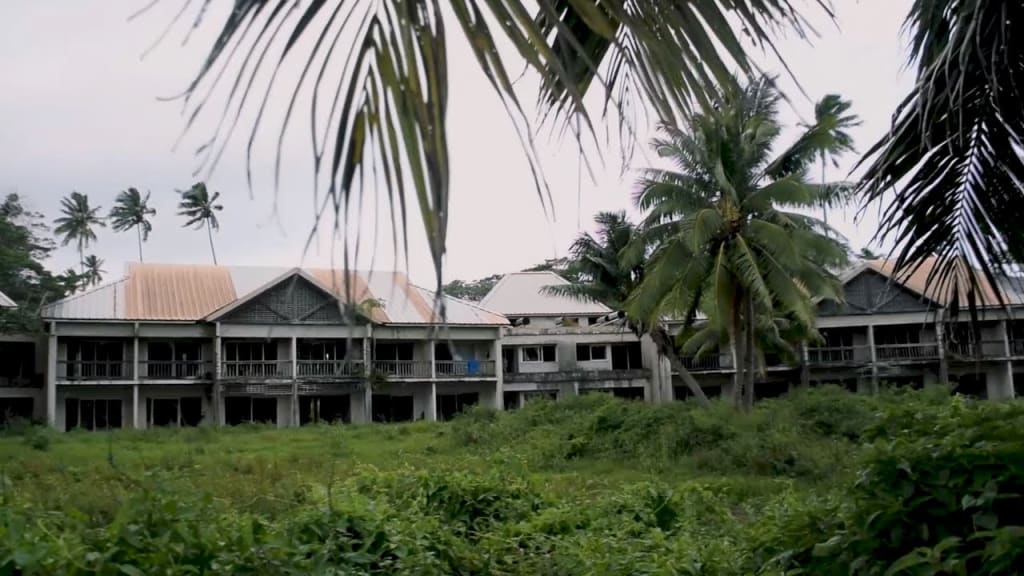Sheraton Rarotonga Hotel, Cook Islands
Abandoned Hotels

Sheraton Rarotonga in the cook islands is not your typical tourist attraction, the ruins of the never completed $80 million Sheraton Rarotonga Resort is a series of derelict hotel buildings on the largest of the Cook Islands.
While there are plenty of beaches to visit, hiking, watersports, and other things to do on the island, we found ourselves strangely drawn to this abandoned hotel on Rarotonga. With lush jungle, clear waters and white sandy beaches, this island seemed like the perfect place to build a luxury resort. Then, it all went horribly wrong.
Today, the ruins tell a tale of politics, organized crime, and a curse.
It was the mid-80s when Italian contractors were hired to build the $80 million Sheraton Rarotonga Hotel. Rather than using local labour, they brought in 360 Italian workers. As one can well imagine, this did not please the local people, especially the Takitumu tribe, the keepers of the land.
The Italians soon built a 250-room hotel and were ready to develop the land. Their plan was to re-route the waterfront road around the complex, thus allowing for a man-made lagoon filled from the sea where the original road sat.
The warm, cerulean waters and pristine sandy beaches of Rarotonga seem like the perfect place for a holiday resort. Guests could wake up in the lap of luxury, enjoy breakfast with a view before meandering down to the calm shore. It was money in the bank, or so it seemed, before it all went horribly wrong. With a circumference of 32 kilometres, Rarotonga is the largest of the Cook Islands. The ring road that circles the island is walkable, but it’s better by scooter or bike.
The phantom resort sat in a jungle clearing. Thick green grass grew around a series of weathered cement pylons that led up to the eerie structure. The unfinished rooms stood in a row at the edge of the foliage. They were neither inviting nor accommodating. A pair of goats munched lazily in front of one of the deserted bungalows. A small would-be admin building, also unfinished, sat near the never completed grand entrance. An unsealed road ran up to form a sort of car park that was full of tin drums. The main island road separated the spooky sight from the beach, but it was easy to see how prime the location was. It looked as if it was just about finished when workers downed tools and walked away … or perhaps vanished into thin air.
The required government consent had to come from New Zealand, as the Cook Islands were their protectorate. At that time, Winston Peters was the Minister of Foreign Affairs. Rather than granting permission, he threw them all out of the country. Our guide dramatically added that Peters discovered that they were, in fact, mafia. The abandoned hotel soon became a collection of derelict buildings.
Many years later, Hilton came in and tried to finish the job, but it was too late as the land had been cursed by a local from the Takitumu tribe. Hilton needed supplies from Australia. They gave $7 million to a representative who travelled to Australia to get the materials, but they never returned. (An interesting twist, in one version of the story, we were told it was that tribal chief who absconded with the funds, but this could not be verified.)
At one stage, Sheraton had been pegged to manage the finished resort, but pulled out before the implosion. Hilton was also briefly attached. Both appear to have dodged a bullet.
Numerous attempts to revive the project had crumbled in the years since. Problems had apparently included the Cook Islands’ prohibitive (but protective) land ownership laws and, perhaps more likely, a rumoured curse on Vaimaanga, the site in question.
Today it sits silent and unloved, except on the rare occasion it’s used as a post-apocalyptic paintball arena. But is the phantom resort a massive missed opportunity? Did its failure impact the Cook Islands’ tourism industry? The answer is as complicated as the site’s history, and perhaps just as uncertain.
The collapse of the hotel in 1990 decimated the Cook Islands government coffers. Skilled locals fled the nation to find work abroad, particularly to New Zealand, with which the Cook Islands has a formal relationship. That hit to the population is still felt today; the head count of just under 17,500 is about what it was in 1980.
The exodus of workers has caused the Cook Islands to steer harder into tourism, which has become the country’s prime industry. The image of a picture-perfect tropical escape sits alongside black pearls as the Cook Islands’ leading export. Rarotonga isn’t exactly hurting for accommodation these days. The island’s booming tourism market is spoiled for choice, with eco retreats and luxury bungalows all around the tiny coast. The island north of Raro, Aitutaki, features a premium private resort on top of one of the world’s most stunning lagoons. The overwater bungalows are among the best in the South Pacific.The phantom resort was built in a time before overwater bungalows and eco tourism. It’s likely it would have been even more of an eyesore had it been completed; a dated hotel begging for a facelift.
In its strange limbo, the unfinished resort has an unexpectedly special afterlife. It’s become an accidental tourist destination.
About the Creator
Tami Osburn
I am just a writer who loves to write. Please enjoy my stories and poems. You can also find me on Amazon.com as an indie writer. Look me up there as well.






Comments
There are no comments for this story
Be the first to respond and start the conversation.